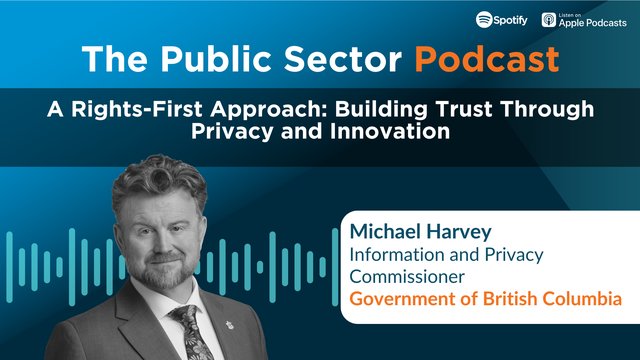Connecting People with Ideas to Build a Better Public Service
Innovators at Work: Partnering to Deliver Better Services
The Prominence of Service Transformation
The term in vogue at the moment, especially for anyone involved in technology or IT, is digital transformation. Essentially that is when organizations update or upgrade their legacy systems and digitize more of their operations. Given our connected world these days, it has become a common and necessary practice. But the Service Transformation team at the BC Ministry of Environment & Climate Change argue that digital transformation is just one subset of a larger process. Kevin Ehman , the Director of Strategic Design at the Ministry, says that the term digital transformation is used interchangeably with service transformation, but we think that digital transformation is kind of nested under the service transformation umbrella. The reason they say that is because service transformation is, or at least should be, thoughtfully and holistically connecting policy to delivery. It’s about transforming your organization to embrace a service orientation and an outward facing service culture.
Jillian Carruthers , the Executive Director of the Service Transformation team at the Ministry, says that the “new Service Transformation branch has only been around for eight months, but in that time they have already worked to create systemic change, not just transactional, in order to facilitate productive relationships and co-collaborations across government. To embed the service changes that will make organizations more innovative and creative, they have developed four principles and number of steps for engagement. Many of these often intersect with digital because that’s the world that we live in, and “they may seem obvious, but within the public sector, each of them is designed to push boundaries and challenge assumptions.
The Principles and Steps for Success
Jillian Carruthers says that the four principles of service transformation are:
- Start with user needs – It’s about both internal and external users, not just about one or the other.
- Delivery is default – Transformation can’t happen on its own.
- We are your accelerators – All change requires capacity and your people can help with that.”
- Program areas must own the change – The ownership has to come from within the organization.
Despite these principles and the identified steps, there really is no guide, manual or playbook. This is emergent work and a lot of it we are processing by feel. Yet despite that, Kevin Ehrman says that service transformation is extremely important because services are how people experience government. Unfortunately though, most of the time it is reactive and generally not in a context which is too pleasant or desirable.
Good service experiences help build trust in government and a belief that government is capable of doing important things. Government needs to meet people where they’re at when delivering critical services. Kevin Ehman , Director of Strategic Design, BC Ministry of Environment & Climate Change Strategy
This is particularly true and visible when it comes to emergencies. In BC for instance, after a flooding crisis, the government stepped up to where the people were at, but generally governments lack in this area. So service transformation is part of a rigorous design and delivery process that meets contemporary expectations, but it is also more than that. Apart from being a holistic change process, it also needs to incorporate digital and leadership competencies. The problem however is that these competencies are often hard to find.
Jillian Carruthers says that as a rational species, we want everything to be simple, to solve a problem and find clarity. But when it comes to government, it has been organized around legislative and policy changes that have stacked up over decades, so it is ultimately designed to be inflexible. There is often chaos and disaster informed largely by the political priority of the day. The unintended consequence of this situation is that as dutiful public servants, we adjust and unintentionally contribute to this incredible organizational debt. If public servants ever try to go against the grain or shut down a project, they usually do a terrible job of it.
Service transformation is therefore about turning this picture around, not simply by recreating the organizational processes and bodies or building on top of the old ones, but by actually creating the right services and good practices. Jillian Carruthers, Executive Director, Service Transformation, BC Ministry of Environment & Climate Change Strategy
In terms of the steps for success, Kevin Ehrman starts with one of the most difficult but important steps:
- It’s ok not to know – We have to be able to sit comfortably in the ambiguity.
This is very hard for many people to achieve and admit. As such, this is really a culture making project. The culture of public sector organizations needs to change because currently, they are built upon this expectation of expertise and some kind of false perfectionism. People want to see the answers but sometimes they ask the wrong questions because they know they don’t have the answers. So we need to ask simple and dumb questions and that means being uncomfortable. It also takes a lot of vulnerability. One way to overcome it is by doing researching, relying more on evidence and engaging with the people who matter in your service value chain. You then have to learn and iterate and continuously improve, which needs to be baked in, even if you don’t get it right the first time.
- Trust – Navigating complexity and gaining an organizational flexibility to respond to emerging demand.
This is about internal and external trust, but in both cases it is really about establishing real human relationships, so that the process of defining a problem and solving it becomes a lot more seamless. Trust needs to come from the staff and leadership teams, and it needs to be built in and transparent. Skimp on this phase at your peril.
- State of readiness – Lean in to change.
Once trust has been established, it can be put to good use by actually implementing novel processes. The BC Ministry of Environment & Climate Change Strategy is all about being ready to make a difference, even though the process we are engaged in is hard to define and hard to quantify, though it is not imperceptible. It is clearly observed because we have a positive and constructive approach, and a tolerance for mistake making. This is part of the executive culture of learning and leading.
- Put ownership where it belongs – Ultimately this is key.
Based on fourth principle above, Jillian Carruthers says that in government, it is common for someone to come in, deliver something and then leave. They then leave you to clean up after them. The ownership is about removing barriers but creating guardrails where they should be. This often takes some patience, but we have to start by untangling the web of complexity.
- Do it now, do it later – This is fast value.
The power of creating builds up trust, and through iteration and real work, you build the state of readiness too. Ultimately transformation and change are not about quick wins, but long value. It is about momentum, and has to be a balance between immediate success and long policy based outcomes.


































